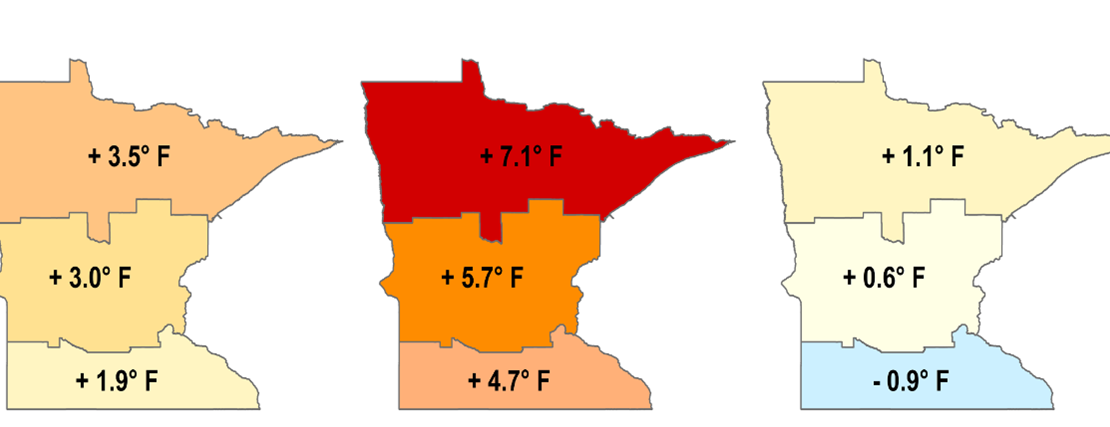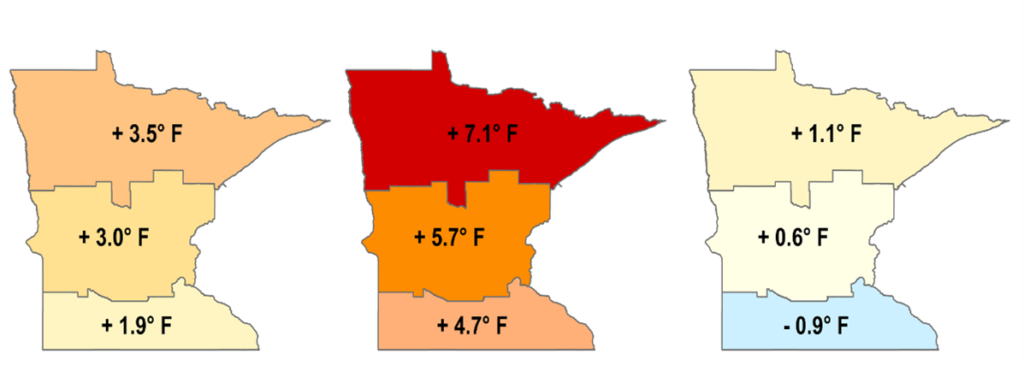A Changing Climate, but what does that mean for Minnesota?

By Jake Richards, IT Specialist Individual Placement / AmeriCorps Member placed at Minnesota Department of Natural Resources, Division of Parks and Trails
Over the past decade, it has been nearly impossible to pay attention to the happenings of the world without hearing about “climate change”. Like many other topics, it is hard to break through the polarized and sensational nature of the media to find out what the important things you should know are. With that in mind, I want to take this month’s blog post to clear some of the murk, focusing on Minnesota as the scope of the conversation. While there are many important topics, I will be focusing on three key categories: Temperature, Water Resources, and Ecosystems. I hope you can learn a thing or two!
Starting with temperature, the biggest clue as to how Minnesota is changing is the shift in recorded average annual temperatures. In recorded history (starting in the late 1800s), 9 of the top 16 hottest years have occurred since 2000. These are considered peak temperatures, but it has also been observed that the state has warmed around 3 degrees Fahrenheit overall. The observed warming has hit the northern part of the state the hardest as well as winters.

Moving along to water resources, this is a particularly important issue for Minnesotans as citizens of the land of 10,000 lakes. Unfortunately, in a similar vein to general temperatures, Minnesota’s water bodies have been warming significantly. This warming has many negative effects on the water, creating shorter periods of ice cover, higher levels of evaporation, and reduced oxygen in the water. One particularly stark consequence of warming water temperatures is the ice cover on Lake Superior. Over the past 100 years, ice coverage on Lake Superior has dropped by 50% as the water warms. This phenomenon has had harmful affects on native wildlife and as temperatures continue to warm, will trickle down into smaller lakes more frequently as well.

The final section I want to focus is how all the factors of climate change affect Minnesota’s ecosystems. Extreme rainfall events, extended droughts, and higher average temperatures are creating a new landscape faster than native species can adapt. For example, moose populations in the north are decreasing due to longer tick seasons while walleye spawning is becoming less efficient in the south due to the cooler temperatures required for their eggs being less frequent. Nature always adapts and these observed effects are not the end of these species but without mitigation these and other species will struggle as their home changes around them.
To wrap this post up, I want to offer a more positive sentiment as the sections above are rather negative. The issues we are seeing pop-up are real but not set in stone. By continuing to make behavioral changes and advocating for social changes we can keep our state intact and livable for all the species that call it home. The fight is nowhere near over and I hope this short blog leaves you more informed but also more engaged to contribute to the fight for our state’s environment.
Sources
climate.umn.edu/our-changing-climate
pca.state.mn.us/air-water-land-climate/climate-change-impacts